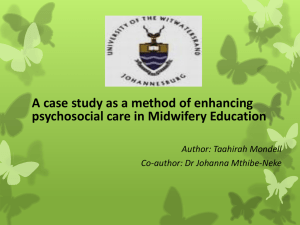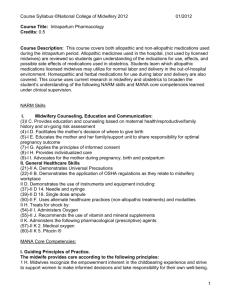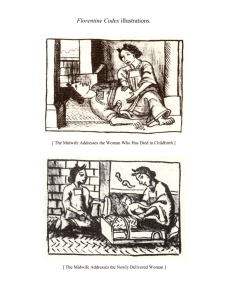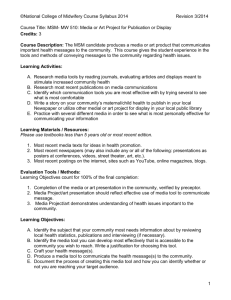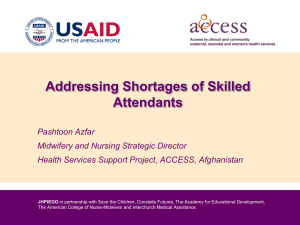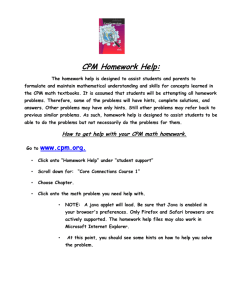The Certified Professional Midwife
advertisement
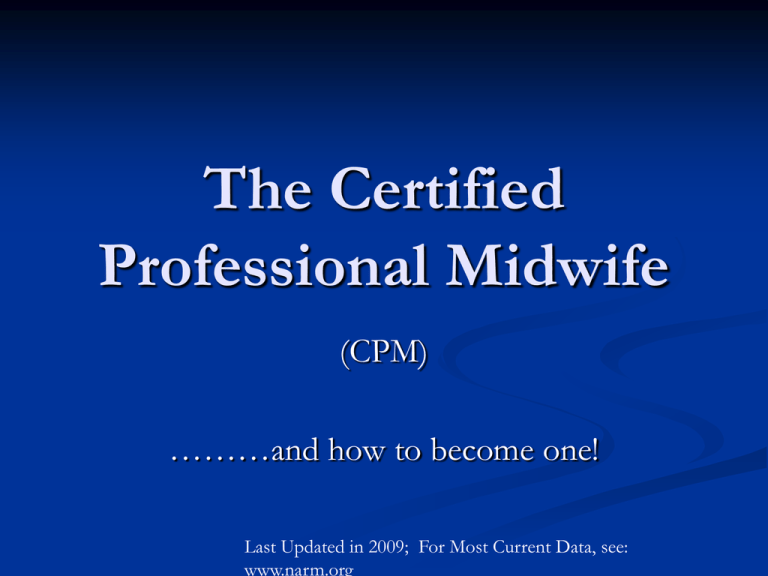
The Certified Professional Midwife (CPM) ………and how to become one! Last Updated in 2009; For Most Current Data, see: www.narm.org What is a Certified Professional Midwife? A Certified Professional Midwife (CPM) is a knowledgeable, skilled and professional independent midwifery practitioner who has met the standards for certification set by the North American Registry of Midwives (NARM) and is qualified to provide the Midwives Model of Care. The CPM is the only international credential that requires knowledge about and experience in out-ofhospital settings. The Midwives Model of Care is based on the fact that pregnancy and birth are normal life events. The Midwives Model of Care includes: monitoring the physical, psychological and social well-being of the mother throughout the childbearing cycle; providing the mother with individualized education, counseling and prenatal care, continuous hands-on assistance during labor and delivery and postpartum support; minimizing technological interventions; and identifying and referring women who require obstetrical attention. The application of this model has been proven to reduce the incidence of birth injury, trauma and cesarean section. CPM Completion of this Certification cannot be seen as legal protection, which is determined by territorial governments. Educational Requirements to Become a Certified Professional Midwife (CPM) The Certified Professional Midwife (CPM) is a knowledgeable, skilled professional midwife who has been educated through a variety of routes. Candidates eligible to apply for the Certified Professional Midwife (CPM) credential include: Graduates of programs accredited by the Midwifery Education Accreditation Council (MEAC); Midwives certified by the ACNM Certification Council (ACC), Inc. as CNMs or CMs; and Candidates who have completed NARM’s competency-based Portfolio Evaluation Process, the PEP Program. NARM recognizes that the education of a Certified Professional Midwife (CPM) is composed of didactic and clinical experience. The clinical component of the educational process must be at least two years in duration under the supervision of one or more preceptors. The average apprenticeship typically lasts 3-to-5 years. All clinicals must have occurred within 10 years of the application submission A preceptor for a NARM PEP applicant must be credentialed as: A nationally certified midwife (CPM or CNM); or a Licensed Midwife The preceptor must have an additional 3 years of experience, or 50 births, including 10 continuity of care births beyond the experience requirements for CPM certification, & the preceptor must have attended at least 10 births in the past 3 years. The preceptor privileges of some midwives have been revoked. It is the student’s responsibility to verify their preceptor’s status by asking their preceptor or contacting NARM. The preceptor(s) holds final responsibility for confirming that the applicant provided the required care. The preceptor(s) must be physically present in the same room in a supervisory capacity during that care and must confirm the provision of that care by initialing the appropriate NARM forms. CPM General Education Requirements Educational Content Areas The education of all entry-level CPM applicants must include the content areas identified in the following documents, which are included in the Candidate Information Bulletin (CIB) section of the application packet A. The Core Competencies developed by the Midwives Alliance of North America; B. The NARM Written Test Specifications, which will be used as the outline and Study Guide for the NARM Written Examination; C. The NARM Skills Assessment Test Specifications, which will be used as the outline and Study Guide for the NARM Skills Assessment; D. The NARM Written Examination Primary Reference List; and E. The NARM Skills Assessment Reference List. Experience Requirements I. II. As an observer, the applicant must attend a minimum of 10 births in any setting, in any capacity. (observer, doula, family member, friend, beginning apprentice). As an Assistant Under Supervision, you must attend a minimum of 20 births, 25 prenatals (including 3 initial exams), 20 newborn exams, 10 postpartum visits as an assistant under the supervision of a qualified preceptor. II. Functioning in the role of Primary Midwife Under Supervision, you must attend a minimum of an additional 25 births: Continuity of Care: Of the 25 primary births required under supervision in Phase 3, 5 require full Continuity of Care, & 10 more require at least one prenatal under supervision. Full Continuity for 5 Primary Births: 5 Continuity of Care as a Primary Midwife Under Supervision will include 5 prenatals spanning at least 2 trimesters, the birth, newborn exam, & 2 postpartum exams. Prenatals for 10 additional Primary Under Supervision births: Students must have attended at least 1 prenatal (in a primary or assisting role) with the mother prior to her labor & birth for 10 of the 20 primary births under supervision in phase 3 (in addition to the 5 with full COC. A minimum of 10 of the 25 births attended as Primary Under Supervision must be in homes or other out-of-hospital settings. At least 10 of the 20 primary births must have occurred within three years of application submission. III. Functioning in the role of Primary Midwife Under Supervision, you must document: A. 75 prenatal exams, including 20 initial exams; B. 20 newborn exams; and C. 40 postpartum exams. The applicant must competently perform all aspects of midwifery care (prenatal, intrapartal, & postpartal) under the direct supervision of the preceptor. Other Required Documentation You must provide: I. A copy of both sides of current CPR (Adult and either Infant or Neonatal Resuscitation) Certification; Other Required Documentation You must provide: II. Written verification by you or your preceptor that you have developed and utilize: A. Practice guidelines; B. An informed consent document; C. Forms and handouts relating to midwifery practice; and D. An emergency care plan. Requirements for Certification by Educational Category The first step toward becoming a Certified Professional Midwife is the validation of your midwifery education. You may validate your education through one of the following routes: Graduation from a MEAC-Accredited Program. Certification by the ACC as a CNM/CM. Legal recognition in states previously evaluated for educational equivalency. Completion of NARM’s Portfolio Evaluation Process (PEP) Program. Legal Recognition in States/Countries Previously Evaluated for Educational Equivalency The purpose of this category is to expedite the application process for individual midwives legally recognized in a state/country listed to the right. Alaska Arizona Arkansas California Colorado Florida Louisiana New Hampshire New Mexico Montana Oregon South Carolina Texas Washington United Kingdom Completion of NARM’s Portfolio Evaluation Process (PEP) Program This category has been developed to facilitate applicants who are primarily apprentice-trained and/or have not graduated from a MEAC-accredited program, are not certified by the AMBC as a CNM /CM, or are not legally recognized in their states, or have not recd. Midwifery training outside of the U.S. NARM’s Portfolio Evaluation Process (PEP) is a competencybased educational evaluation process that includes NARM’s Skills Verification. There are 3 PEP categories: Entry-Level, Internationally Educated, & Experienced Midwives. Candidates applying for certification through NARM’s PEP Program will undergo a 3-step process: STEP 1: Verification of experience and skills through NARM’s PEP Program. STEP 2: Application for Certification STEP 3: Certification CPM Certification: A Summary You must: I. Complete the NARM General Application and CPM Application forms. II. Submit educational validation (along with additional documentation if necessary) for one (1) of the following educational routes of entry: A. Graduation from a MEAC-Accredited Program. B. Certification by the AMBC as a CNM/CM. C. Legal recognition in states/countries previously evaluated for educational equivalency. D. Completion of NARM’s Portfolio Evaluation Process (PEP) Program. III. Pass, or submit evidence of having passed, the NARM Written Examination. Recertification Certification must be renewed every three years. Thirty (30) continuing education contact hours are required during the three-year period. These must include 5 contact hours of peer review. One contact hour is defined as fifty-five (55) clock minutes of time. .5 (half) contact hours are awarded for thirty (30) minutes to fifty-five (55) minutes. Fewer than 30 contact minutes will not be awarded continuing education contact hours. Mandatory Areas Peer Review—5 contact hours (Participation in Peer Review and/or attendance at Peer Review workshop) Current CPR and Neonatal Resuscitation Documentation of workshop, course or module on cultural competency (if not already submitted) Affirmation of current use of practice guidelines, informed consent & emergency care forms Demographic information Two Options for Recertification 1. Mandatory Areas + 25 contact hours from a mixture of categories 2. Mandatory Areas + retaking the NARM Written Examination Fee Schedule PEP Application Fees run around $1100. Current examination fees are $900. Recertification Fee $150-$200. Midwives who have previously passed the NARM Written Examination may subtract the fee paid for the examination taken from the certification fee. NARM Written Exams taken prior to 1995 will no longer be accepted for CPM Certification. *The PEP Program was specifically designed to enable midwives to obtain certification by providing a mechanism for evaluating their knowledge, skills, and experience. This fee reflects the amount of work and time required for processing a PEP candidate's application and administering the NARM Skills Assessment. NARM NARM General Information (770) 381-9051 (888) 842-4784 info@narm.org www.narm.org MANA Midwives Alliance of North America 888-923-MANA Info@mana.org www.mana.org MEAC Midwifery Education Accreditation Council info@meacschools.org www.meacschools.org For information about MEAC accredited midwifery programs Practical Skills Guide for Midwives (PSGM) Morningstar Publishing PO 671427 Chugiak, AK 99567 888-609-PSGM http://www.morningstarpub.com/
